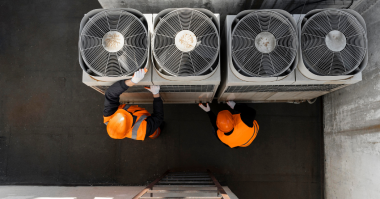Without question, liquid storage terminals play an integral role in the ongoing success and relevance of a wide array of industries around the world. These facilities serve as a vital hub in the storage and dispersal of numerous types of liquids, including vegetable oils and fats, oleochemicals, petroleum products and petrochemicals, all substances that are vital in the world’s transportation and manufacturing sectors. In short, any liquid that can be transported in bulk—be it by ocean-going tank ship, barge, railcar, tank truck or pipeline—is, at some point in its supply chain, stored and transferred at a liquid terminal.
But while the range of products that may pass through a liquid storage terminal is wide and varying, the operating conditions at most terminals are quite similar—harsh, oftentimes corrosive, atmospheres that require around-the-clock equipment reliability with any downtime having a potentially hugely adverse effect on the terminal’s operation and profitability.
Transfer pumps used in these conditions are under constant assault and must be able to perform reliably while handling a number of diverse operating characteristics, such as:
- Changes in ambient temperatures and other weather conditions, such as humidity
- Line shock from piping that is not anchored down properly
- Piping systems that have sharp bends instead of gentle curves
- Changes in the product type being pumped
- Changes in product viscosity
- High volume (unloading a 50,000-gallon tanker) at high flow rates (4,000 gallons per minute)
- Changes in product velocity and force
- Changes in head pressure
Taking all of this into consideration, this white paper will focus on the role of centrifugal-pump technology in liquid-terminal applications. It will also show how proactive steps in both preventive and protective maintenance can keep the pumps running reliably in environments that put the pump’s effective operation under constant threat.
The Maintenance Solution
Centrifugal pumps move liquids through the use of centrifugal force. The three common styles of centrifugal pumps are:
- ANSI — These pumps meet centrifugal-pump manufacturing criteria established by the American National Standards Institute (ANSI) in 1977. With that standard in mind, ANSI centrifugal pumps are engineered for operational flexibility and durability, and can meet the needs of virtually any fluid-transfer application.
- Standard End-Suction — Ideal for thin liquids and the top choice for most water-pumping applications.
- Self-Priming — Balanced pumping pressures prevent product recirculation, making these pumps ideal for high-capacity loading and unloading operations.
No matter the operational atmosphere where these, or any, type of pump is being use, a routine maintenance program will extend the life of the pump since well-maintained equipment lasts longer and requires fewer and less-expensive repairs. A detailed record of any preventive maintenance that was performed and repairs that were needed should be kept in order to help diagnose problems and eliminate, or minimize, any future equipment downtime.
Routine preventive and protective maintenance practices should, at a minimum, include the monitoring of:
- Bearing and lubricant condition. Monitor bearing temperatures, lubricant level and vibration. The lubricant should be clear with no signs of frothing, while changes in bearing temperature may indicate imminent failure.
- Shaft seal condition. The mechanical seals should show no signs of visible leakage. Any packing should leak at a rate of about 40 to 60 drops per minute.
- Overall pump vibration. Imminent bearing failure can be preceded by a change in bearing vibration. Unwanted vibration can also occur due to a change in pump alignment, the presence of cavitation or resonances between the pump, its foundation or the valving located in the suction and/or discharge lines.
- Pump discharge pressure. The difference between the readings on the suction and discharge gauges will provide the total developed head pressure of the pump. A gradual decrease in the developed head pressure of the pump can indicate that the impeller clearance has widened, which requires an impeller clearance adjustment to restore the pump’s intended design performance.
To stay on top of these potential maintenance concerns, Griswold™ Pump Company, a leading centrifugal-pump manufacturer, suggests the following basic maintenance regimen. Also worth noting is that maintenance and monitoring intervals should be shortened if the pump is used in severe-service conditions, such as with highly corrosive liquids:
Quarterly Maintenance
- Check the pump’s foundation and hold-down bolts for tightness
- For oil-lubricated pumps, the oil should be changed after the first 200 hours of operation for a new pump then after every three months or 2,000 operating hours, whichever comes firs. For grease-lubricated pumps, you should regrease bearings every three months or 2,000 operating hours, whichever comes first
- Check the shaft alignment
- Regrease motor bearings according to the manufacturer’s instructions
Annual Maintenance
The pump’s performance should be checked and recorded in detail at least once a year. Performance benchmarks should be established during the early stages of a pump’s operation when the parts are new and the installation adjustments are correct. This benchmarking data should include:
- The pump’s developed head pressure as measured at the suction and discharge gauges
- Pump flow rate
- Motor amp draw
- Vibration signature
When the annual assessment of a pump’s performance is made, any changes in the benchmarks should be noted and used in determining the level of maintenance that may be required to get the pump back to operating at its efficient best.
When considering centrifugal-pump operation and maintenance requirements, one thing must be kept in mind: all pump bearings will fail eventually. However, the cause of bearing failure is more often than not a failure of the lubricating medium, not equipment fatigue. Therefore, particular attention needs to be paid to bearing lubrication in order to maximize bearing and, by extension, pump life.
If an oil is being used for bearing lubrication remember to use only non-foaming and non-detergent oils. The proper oil level is at the mid-point of the bull’s-eye sight glass on the side of the bearing frame. It is important to avoid over-lubrication as it can be just as damaging as under-lubrication since excess oil will cause a slightly higher horsepower draw and generate additional heat, which can cause frothing of the oil. When checking the condition of the lubricating oil, if any cloudiness is observed it can be indication that a water content—which is commonly the result of condensation—of greater than 2,000 ppm is present. If this is the case, the oil needs to be changed immediately.
If the pump is equipped with regreaseable bearings be certain to never mix greases of differing consistencies or types. Also note that the shields must be located toward the interior of the bearing frame. When regreasing, ensure that the bearing fittings are absolutely clean as any contamination will decrease bearing life. Overgreasing must also be avoided as this can cause localized high temperatures in the bearing races and create caked solids. After regreasing the bearings may run at a slightly higher temperature for a period of one to two hours.
In instances where a terminal operator may need to replace a part, or parts, on a malfunctioning pump, these circumstances should also be treated as an opportunity to examine the pump’s other parts for signs of fatigue, excessive wear and cracks. At this time, any worn parts should be replaced if they do not meet the following part-specific tolerance standards:
- Bearing Frame and Foot — Visually inspect for cracks, roughness, rust or scale. Check machined surfaces for pitting or erosion.
- Bearing Frame — Inspect tapped connections for dirt. Clean and chase threads as necessary. Remove all loose or foreign material. Inspect lubrication passages to be sure that they are open.
- Shaft and Sleeve — Visually inspect for grooves or pitting. Check bearing fits and shaft runout, and replace the shaft and sleeve if worn or if the shaft runout is greater than 0.002 inches.
- Casing — Visually inspect for signs of wear, corrosion or pitting. The casing should be replaced if wear exceeds 1/8-inch deep. Check gasket surfaces for signs or irregularities.
- Impeller — Visually inspect the impeller for wear, erosion or corrosion damage. If the vanes are worn more than 1/8-inch deep, or if they are bent, the impeller should be replaced.
- Frame Adapter — Visually inspect for cracks, warpage or corrosion damage and replace if any of these conditions are present.
- Bearing Housing — Visually inspect for signs of wear, corrosion, cracks or pits. Replace housings if worn or out of tolerance.
- Seal Chamber/Stuffing Box Cover — Visually check for cracks, pitting, erosion or corrosion, paying special attention to any wear, scoring or grooves that might be on the chamber face. Replace if worn more than 1/8-inch deep.
- Shaft — Check the shaft for any evidence of corrosion or wear. Check the shaft for straightness, noting that the maximum total indicator reading (TIR) at the sleeve journal and coupling journal cannot exceed 0.002 inches.
Implementing all of these maintenance recommendations may seem daunting, but it is only through a routine such as this that a fluid-handling operation can maximize the service life of the equipment while enhancing the safety of plant personnel and the environment.
Conclusion
As mentioned, the harsh, difficult operating conditions at liquid terminals can put a great deal of stress on the pumping equipment that is used to keep them running 24/7/365. The best way to ensure that instances of equipment failure that lead to costly downtime and potential safety hazards do not occur is to be proactive in your maintenance routine. This means establishing a maintenance schedule for every pump and documenting every maintenance occurrence, whether planned or unplanned. Liquid-terminal operators who stay ahead of the maintenance curve will reap the benefits of a facility that operates without encountering the breakdowns and out-of-service situations that can set an operation back.
Rick Whidden is Applications Manager for Grand Terrace, CA-based Griswold™ Pump Company, an operating company within Pump Solutions Group (PSG™). He can be reached at (800) 843-9222 or Rick.Whidden@griswoldpump.com. PSG is a member of Dover Corporation and comprised of seven leading pump brands — Wilden®, Blackmer®, Griswold™, Neptune™, EnviroGear®, Almatec® and Mouvex®. You can find more information on Griswold at www.griswoldpump.com and PSG atwww.pumpsg.com.




Comments